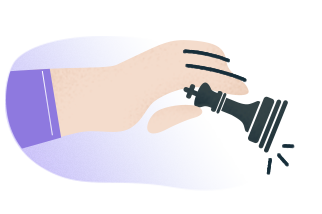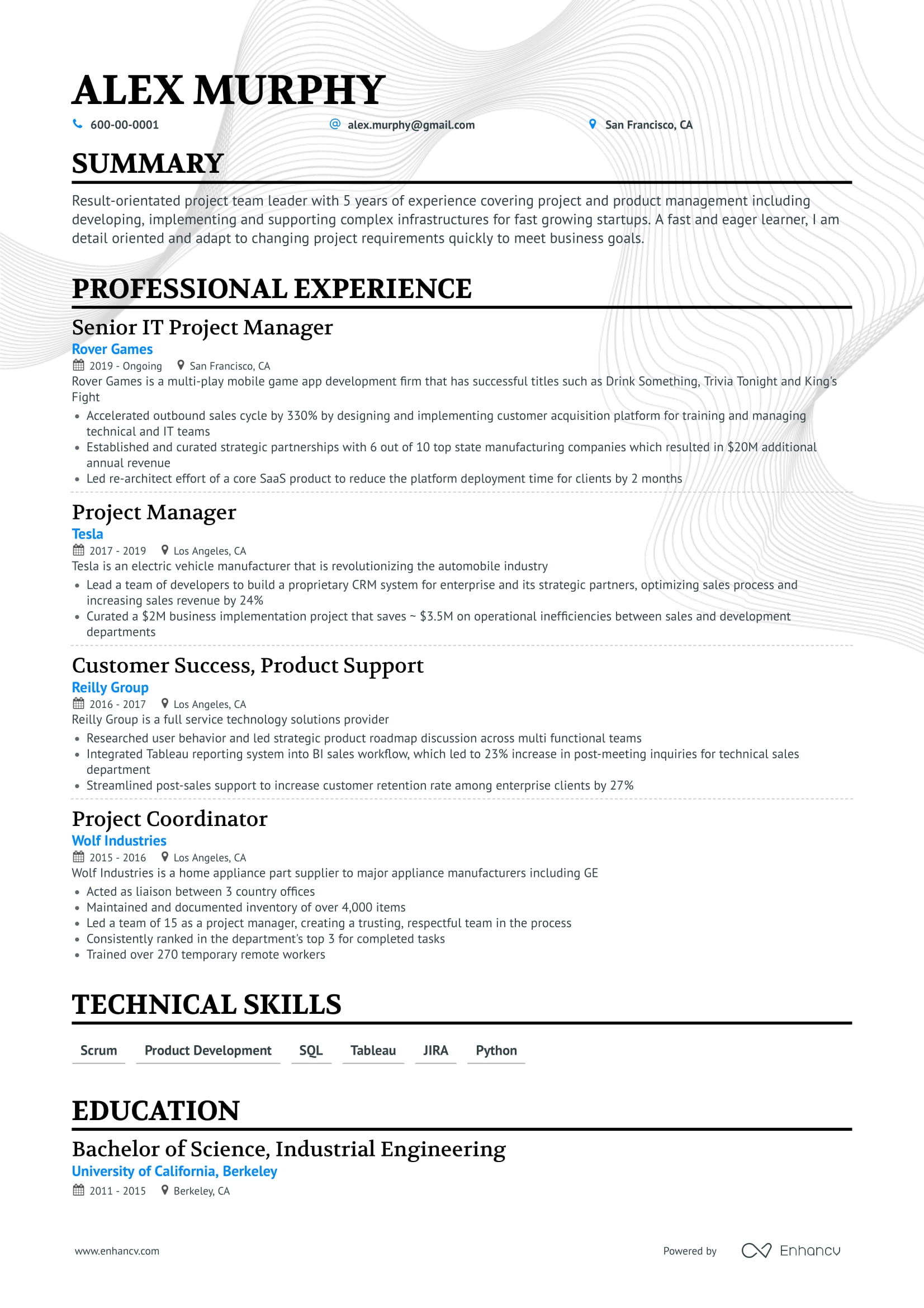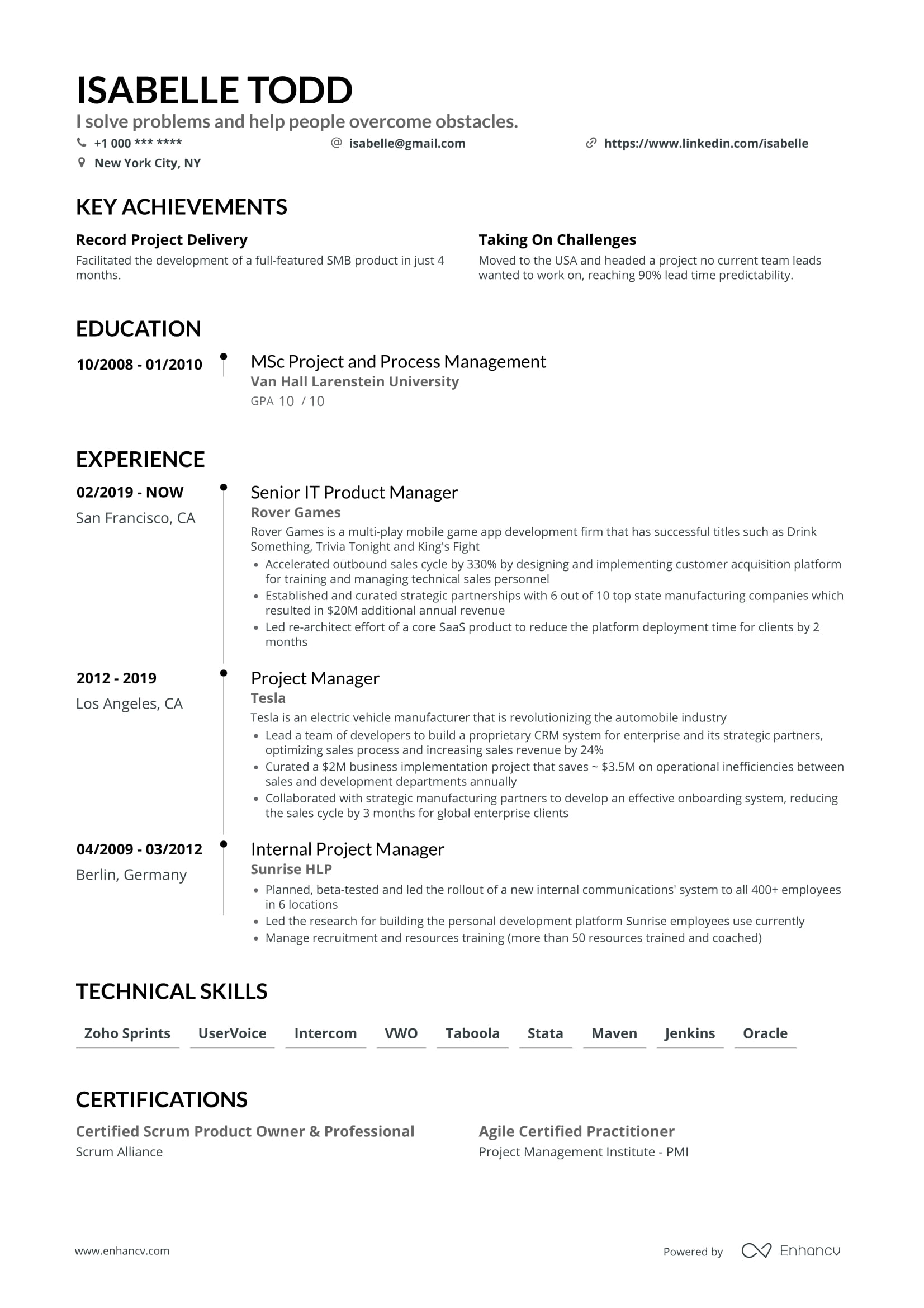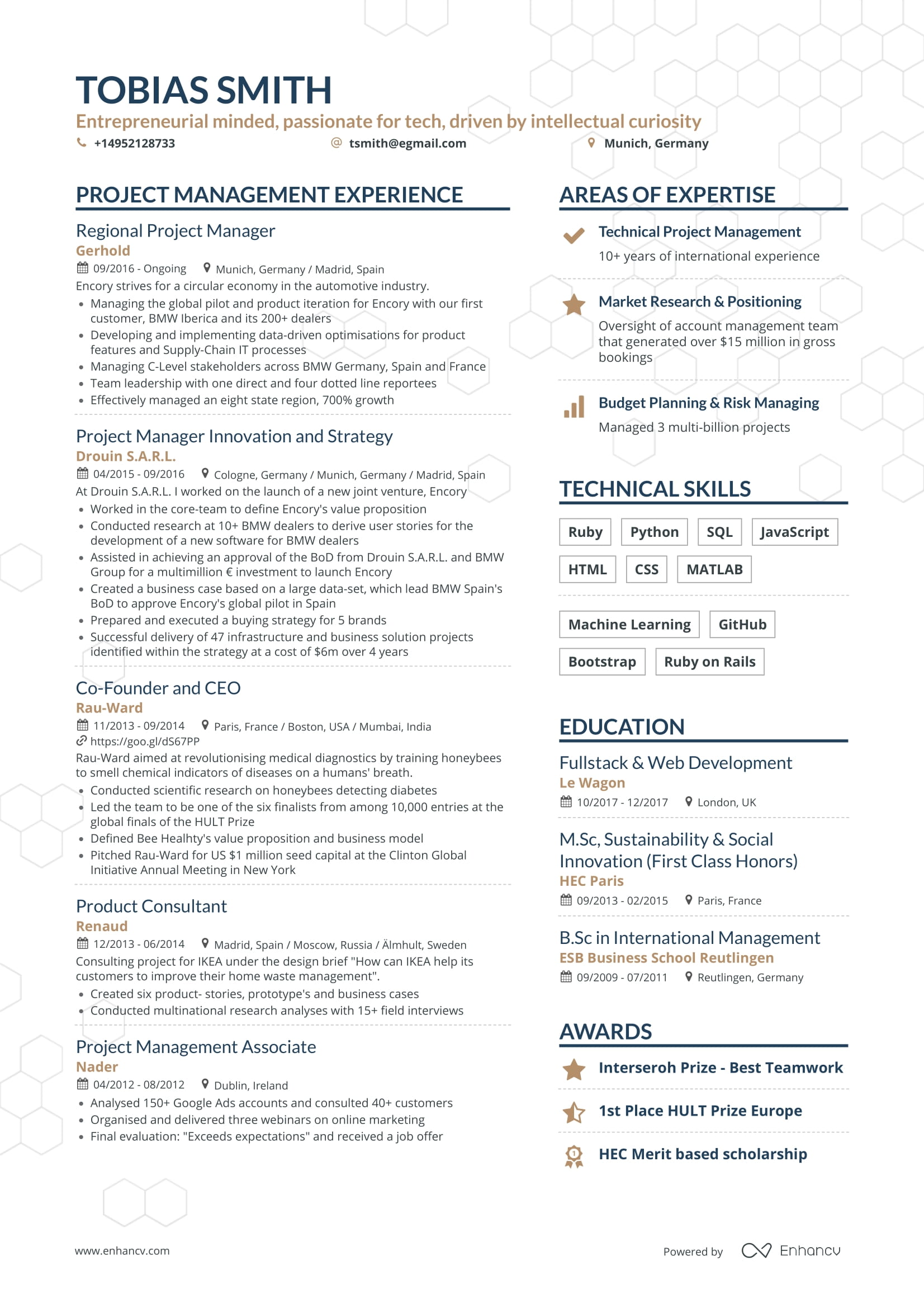Example Front End Developer Resume - Browse more resume templates and build a stand-out resume
Applying for a front-end developer position can be exhausting.
First, you have to pass an automated filter system. Then, your F/E dev resume will be analyzed and criticized by non-tech personnel. Ugh...
And only then someone who can tell the difference between Bootstrap and Flexbox gets to look at it in detail.
In other words, your web developer resume has to withstand three absolutely different types of tests to land you an interview.
But there is good news: we know how to do that.
Over the years, we tested and improved our approach with thousands of software engineers and developers. It wasn’t easy, but definitely worked in the long run. Our clients’ resumes got into Amazon, Spotify, and even Mark Cuban’s direct.
What you will learn from this front end developer resume guide:
- How to properly stand out with your Front End resume in 2022
- What is the main difference between a bad front end dev resume and a great one
- Entry-level front-end resume example that showcase common mistakes, and how to fix them
- How to balance technical and soft skills to show you’re well-rounded
- Using quantitative data to show the measurable impact you can make
- The best way to showcase your education, certifications, and projects
Looking for other Front End Related Resume examples?
- Tech Resume
- Full Stack Developer Resume
- Web Developer Resume
- Web Designer Resume
- Computer Science Resume
Front End Developer Resume Examples
Front End Developer Resume Examples
Entry-level Front End Developer Resume Template and Tips
Junior front end developers have two problems: lack of experience and lack of confidence.
The following tips will help you address all issues before recruiters spot them:
- Don’t overstuff your resume with technical skills. Sometimes aspiring developers want to impress recruiters and fill their resume with all web technologies and platforms they ever heard of. This is a major red flag for recruiters and usually happens when ill-fit applicants copy entire sections of someone else’s resume into their own. Recruiters understand that entry-level developers are not a walking wiki, so focus on a handful of skills you know first-hand to get your best shot.
- Showcase software-related personal projects. Surely, recruiters don’t expect you to have years of software experience as a junior developer. But what they want to see is your passion for software development and the ability to finish projects.Personal projects are a perfect way to demonstrate both skills and work ethics. It doesn’t matter if you were helping create a website for your friend or developed an indie flash game that one downloaded. The mere fact of finishing something you cared about paints you as a great front end developer in the makings. Usecustom resume sections to feature personal projects in an engaging and compact manner.
Senior Front End Developer Resume Template and Tips
- Showcase leadership and management skills in context. The ability to lead and manage is a fundamental skill for any manager, but proving it with your resume may be challenging. That’s why you don’t simply list “leadership”in your skill section. You need to show your leadership qualities in a real-world context. Hint at how you led a team of developers when describing your work experience. Share how you saved a project no one believed in. Recruiters love candidates that have examples like that.
- Use a targeted resume. Make an effort to study as much as possible about your target company, and then use this information to enhance your resume.Learn about their tech stack and mention relevant expertise in your skills and experience section. Learn how big or small is their team and share how you worked with the same group of people and what challenges did you overcome. Finally, if your target company works with a product and niche that you know, try thinking about challenges they might have now and demonstrate work experience solving them. Use atargeted resume approach to boost your chances of successful application for senior positions.
How to write a stand-out front end developer resume
Automatic filters (ATS scanners) will be scanning your resume for keywords and mistakes.
Non-tech recruiters will be looking at your work experience and skills.
Technical recruiters and your future team leads will be looking for your approach and potential.
Does your F/E dev resume have all that?
Here’s a quickchecklist of what should be in your front end web dev resume:
- Relevant experience as a front end developer
- The right stack of technical and soft skills
- Professional achievements that can be backed up with data (eg. boosted mobile traffic by 40% with your redesign)
- Genuine passion and excitement for the role
How to achieve all that?
Your resume must show that you not only have the technical know-how to produce well-designed code, but also that you can deliver tangible business results with it too.
Soft skills, including cross-team collaboration, time management, and understanding user behavior, are huge assets as a front end developer.
Every job role has its own specific needs, and those are usually clearlydefined in the job description. Check out the “Responsibilities” or “Requirements” sections to see what they’re looking for in the ideal candidate.
Then,tailor your resume to meet those needs.
Use the same keywords they use to show that you’ve done your research and that you’re the perfect fit for the role (as long as you genuinely have those skills).
Use areverse chronological resume format to emphasize your experience and accomplishments.
If you’re fresh out of college or just starting your career as a front end developer, afunctional resume format would suit you better, so you can focus more on your education, skills, and certifications.
Whichever format you choose, make sure it’s clearly organized withheadings, scannablebullet points, and aneasy-to-read font andcolor scheme.
Let’s take a look at what you should write for eachsection of your resume.
Recommended resume sections for a front end developer
- Resume header
- Professional summary
- Accomplishment-based work experience
- Education and certifications
- Technical and soft skills
What recruiters want to see in a front end developer resume
- Experience section relevant to the job you’re applying for
- The right skills for the job (based on the posting)
- Quantifiable achievements (Developed 20 apps with react & react-native in a month)
- Examples of what makes you unique (Your usual day or your favorite books)
- What you’re most proud of (displayed creatively)
If you want a different format for your resume, check out our guide:The Best Resume Formats You Need to Consider (5+ Examples Included).
Front End Developer Resume Header: How to Start On The Right Foot
The header is the first thing hiring managers will read after picking up your resume.
It’s the section where you’ll make the first impression.
Make it a good one, and you’ll be off to a great start.
Here’s how:
This resume is fine, but it could be more descriptive.
Let’s add more detail to the next one.
This header will make a great first impression. It lists the seniority level of the candidate and has a link to their GitHub profile, so the hiring manager can check out their projects directly.
Adding a LinkedIn profile or personal website is also a great idea to include.
Make your resume header unique with this guide:Perfecting Your Resume Header so You Get Noticed
Front End Resume Summary: Making Recruiters Love You In Two Sentences
This is where you really start to dive deep into what you can do for the company.
First things first, personalize the summary to match the role you’re applying for. Don’t use the same generic summary for every application you send out.
Personalize your resume to reflect the job description.
This will dramatically improve your chances of being selected for an interview.
Read the job description to see what they value most in a candidate and the skills that are most important to them.
Think back to your own career accomplishments and find opportunities to relate them to the responsibilities of this role that you want.
How will your past achievements reflect how you can make a positive impact as the front-end developer for this new company?
Your professional summary should cover these three bases:
- Overview of your seniority and experience level as a front end developer
- Highlights of your top career accomplishments backed up by real data
- Uses the same keywords and phrases as the job description
Here are two examples of what a front end developer summary looks like.
This summary needs some work.
- It doesn’t indicate the experience level of the candidate
- It only lists off responsibilities, not achievements
Here’s a better example.
Now that’s a summary worth hiring over.
Here’s why:
- Mentions the seniority level and years of experience
- It’s super specific about the skill-set, and it’s relevant to the hypothetical job description
- Uses quantitative data to back up claims and show that the candidate has made a tangible impact on business in the past
Check out our detailed guide onCrafting Job-Winning Resume Summary with more than 30+ actionable examples.
Now that the summary is done, let’s explore the work experience section.
Front End Developer Resume Experience: How to Frame Your Work Experience And Instantly Get Shortlisted
The work experience section will be the highlight of your resume. This is the section that hiring managers care most about.
They’re doing a quick scan to answer these questions in mind:
Do you have related work experience that will make you an asset to this role (eg. If they’re in the bitcoin space, they’ll prioritize candidates with bitcoin experience)?
Also, have you made a positive impact in your work experience that can be backed up with data?
This can mean boosting revenue for the company, improving their success metrics, or saving them money.
These achievements will all inspire confidence in the recruiter that you can do a great job.
Like we mentioned before, it’s essential that you personalize your resume for the position you’re applying for. Don’t send out the same resume to every company. Hiring managers have high expectations and they want to see that you have genuine passion and interest for their job opening specifically.
The work experience section is a great place to add that personal touch, by mirroring the same keywords that they use in the job description.
Also, make an effort toproperly use buzzwords on your resume.
Do they want someone who can work with clients directly and meet their needs? Then mention how in the past, you’ve maintained excellent relationships with your clients.
Do they want someone with experience evolving in Agile/Scrum development cycles? Or a front end developer with excellent knowledge of W3C web standards?
Every job has its own specific requirements. The hiring manager is looking out for resumes that call out to these directly. If you have the skills, weave them into your experience section descriptions.
Use quantitative data to back up your claims of achievement. Include real money figures, percentages, and numbers to add credibility.
All of those factors combined will result in a stand-out experience section that will help you land an interview.
Let’s look at some examples to see our tips in action.
This is how most people write an experience section.
It’s boring and it won’t stand out.
Not only that, but it also doesn’t say anything about the quality of your work.
Let’s try this again.
This one’s much better. Here’s why:
- It highlights the top accomplishments in the role, instead of listing responsibilities
- Quantitative data, in the form of percentages, backs up claims and boosts credibility
- It touches on the soft skills that are important too, such as presenting findings to decision-makers
Need more actionable advice? Check outHow to Cover Work Experience On Your Resume
Now that the experience section is complete, let’s move on to education and certifications.
Front end Developer Education Section: What to Include?
Most front end developer positionsrequire formal education, like a B.A, B.S, or M.S in a technical field.
Some companies will still hire candidates who don’t have a university degree, as long as they have experience, accomplishments, and certifications to make up for it.
If you do have a college degree, list the name of the institution you attended, the name of your program, and the years you attended.
For extra bonus points, list a few relevant courses or projects you completed during your time in college.
Front end Developer Certificates: Do You Need It?
Certifications are a great way to boost your credentials as a front end developer. Whether you have a formal college education or not, they’re a great added bonus to your resume.
Luckily, there are tons of reputable certifications on the market for front end developers.
Make sure the ones you’re listing are considered legitimate in the industry.
Here are a few popular ones to choose from:
- Professional Certificate in Front-End Web Developer by W3C
- The Web Developer Bootcamp (Udemy)
- Front End Web Developer Nanodegree Program by Udacity
- Front End Web Development with React
- UX/UI Design Specialization by Calarts
For more information on how to properly list resume certifications, we recommend reading our guideHow To List Certifications On A Resume (Examples Included).
Front End Developer Skills Section: What to Highlight, What to Get Rid Of
Front end developers have many technical skills.
The most important being coding, especially with HTML, CSS, and jQuery.
With those basics covered, most jobs will require knowledge of extra languages and software.
They’ll list them out in the job description, so read closely to see exactly what they want from you.
For example, do they need someone who has experience with React, Vue.js, and React-Native?
Or someone who has built apps for the financial industry before?
These keywords should appear directly in yourlist of skills if they apply to you.
On top of these technical skills, the perfect candidate will demonstrate their soft skills too. These are the skills that help you translate your technical knowledge into tangible results for the business, like a boost in revenue or cost savings.
Soft skills include collaborating with team members, meeting deadlines, working directly with clients, and presenting information to executives to make decisions.
Build confidence in the hiring manager that you can not develop front end projects with ease, but that you’re also going to be a valuable asset to their team by delivering real results.
Other sections to include on your resume
Depending on the company, job seniority level and your location, you may want to include more sections to your Front End Developer resume:
- Language skills
- Hobbies and interests
- Projects
- Volunteer work
- Highlights
- References
- LinkedIn on Resume
- GPA
- Resume Awards
- Publications
Cover Letter for an F/E Developer
In case the job description says you need to provide a cover letter, do include yours. Otherwise, you can always leave it out.
Nowadays, job application forms include questions like “why do you want to work here”, or “explain why you’re the best fit for us”, which makes you wonderare cover letters really necessary?
Still, they help youtell your story in a way that, if written right, it’s captivating and engaging.
In any case, you should pay close attention to the following tips when a cover letter is a must:
- Make sure you go over acover letter checklist, not to forgetwhat your cover letter should say;
- Match thecover letter design with your resume’s;
- Address your cover letter properly;
- Keep an eye on yourcover letter length;
- Use a propercover letter ending;
If you need more inspiration for a Front End Developer cover letter, check out our60+ Cover Letter Examples.
Key Takeaways: Front End Developer Resume
- Support your claims of success with tangible business outcomes, proving that you’ve made a real business impact in the past (e.g. met client needs, increased revenue, boosted site traffic, reduced the need for support, etc.)
- Personalize your resume for the job you’re applying for by carefully looking at the job description and mirroring the same keywords they use. Ingrain the languages, frameworks, libraries, tools, platforms, etc. that they mention in the job description. No lying though!
- Format your resume to be easy-to-read and scannable, since hiring managers will spend only a few seconds deciding if they want to read further.







